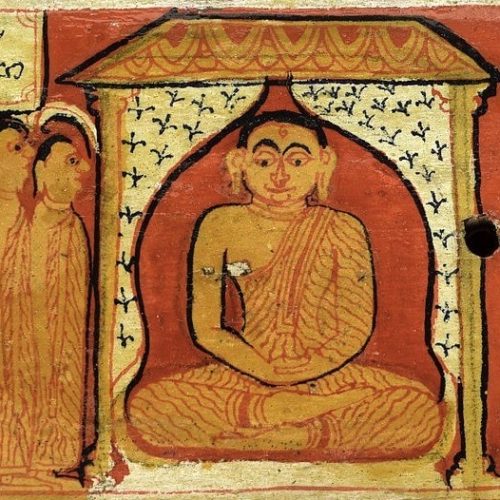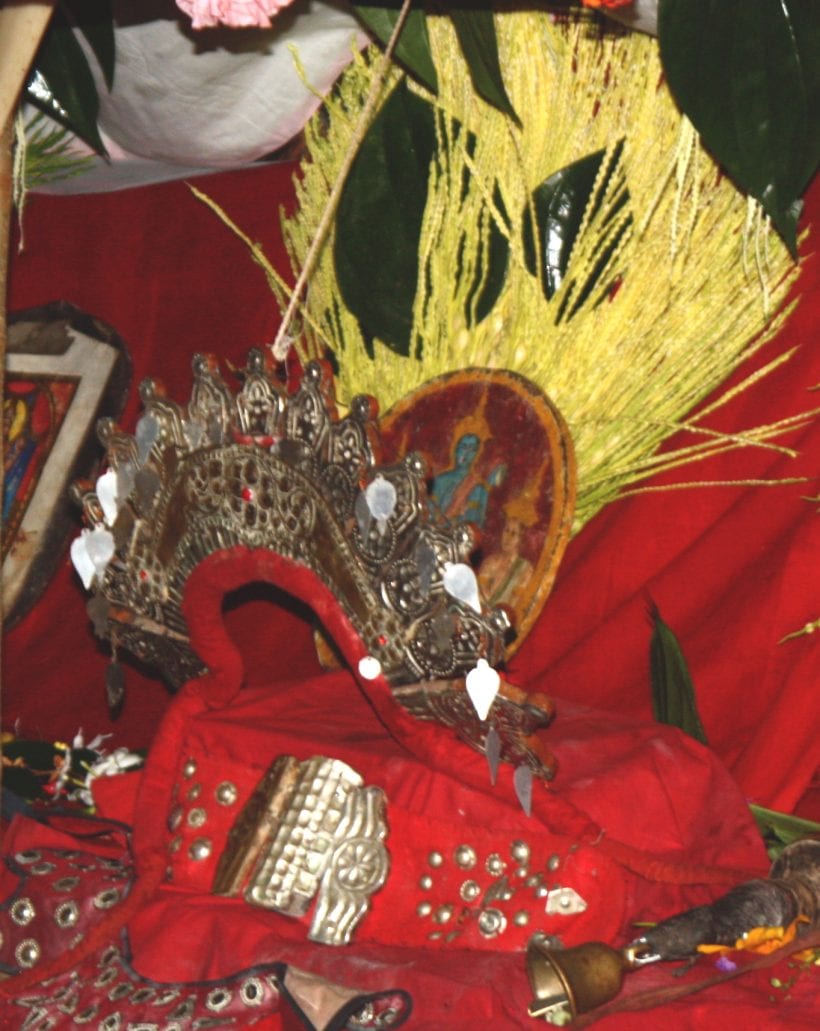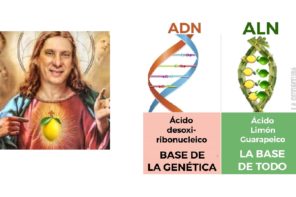The sun had already set when the night-long live broadcast of a kohoḿbā kankāriya ritual in a Sri Lankan town begins. A larger-than-life image of the leading national politician who is, together with ‘the nation’, the addressee of the ritual, towers over the space. The omnipresent cameras spotlight the twenty performers whose elaborate dance movements are keeping up with the rhythm of the drums. Their sacred headdresses are held upright even as they sway their bodies back and forth. Once the drums fall silent, they press their palms together and bow towards the state officials who sit on a mat facing the altar for the kohoḿbā deities, the trinity of gods invoked in the ritual. With the first sunlight flooding the venue, everyone approaches the altar to make offerings and the ritual is over.
These acts of ritual labor turned the venue into an appropriate place for the gods.
The leading ritual practitioners, however, had been at the venue for days to conduct a series of elaborate purification ceremonies. These acts of ritual labor, that are based on knowledge preserved in traditional performer lineages, were of utmost importance since they have turned the venue into an appropriate place for the gods. They are thus practices that mediate the sacred. Yet the live broadcast omitted these acts and encompassed only the second night of the ritual that centered on the enactment of its myth of origin with its allusion to kingship. In this way, the mediatization of the kohoḿbā kankāriya, as a practice of mediating heritage, sought to evoke a particular idea of ‘the nation’ whose heritage is allegedly staged there.
Heritage Rituals
This sketch allows some impressions of a spectacular performance designed around two forms of mediation to render the presence of ‘the nation’ and the gods tangible (Meyer 2008): the mediatization of its visually appealing elements as ‘national heritage’ on the one hand, and the creation of a temporary space for deities through ritual labor on the other hand. I call such performances ‘heritage rituals’ (cf. Brosius 2011) to account for the materialization of the gods within what is staged as heritage – not as an indicator of heritage ‘out of control’, but reflecting the hybrid nature of kohoḿbā kankāriya nowadays (Reed 2010: 177): performed to celebrate the heritage ‘of the nation’ and as blessing rituals.
The kohoḿbā kankāriya is a pre-Buddhist ritual tradition, conducted for warding off misfortune. Its myth of origin states that the first kohoḿbā kankāriya was held in the 5th century BCE to cure king Panduvasudeva from a curse that was inflicted on the lineage of his uncle Vijaya, the mythological Ur-father of the Sinhalese. From the 19th century onward, during the British colonial period, its elaborate dances have been adapted and put on stage as entertainment. After Sri Lanka’s independence in 1948, the kohoḿbā kankāriya tradition and ves dance, a generic term for dance forms based on the ritual, have been turned into national icons of Sinhalese Buddhist heritage (Reed 2010). Sinhalese Buddhists form the ethnic majority of the country and urumaya, the Sinhala term for heritage stemming from the realm of kinship notions of inheritance, evolved from the first half of the 20th century onward as a buzzword for nationalists (Roberts 2001).
The kohoḿbā kankāriya sketched above featured in the period immediately following the end of the war in 2009 when heritage spectacles all over the country were organized to mark the allegedly reunited island as Sinhalese Buddhist, thereby further marginalizing Tamil-speaking and other minorities. The kohoḿbā kankāriya under discussion also sought to invoke ‘the nation’ as Sinhalese Buddhist. It was supposed to align the politician and ‘the nation’, the āturayās or addressees of the ritual, with a ritual tradition that is associated with what is read by Sinhalese Buddhist nationalists as Sinhalese kingship. Yet it was not intended as a mere show but as a ṣāntikarma, an ‘act of blessing’, thus ritual practitioners from traditional performer lineages were entrusted with its performance as the only ones skilled in interacting with the kohoḿbā deities.
Any allusion to the ritual as a pre-Buddhist tradition has to be concealed.
The organization and funding of the kohoḿbā kankāriya under discussion was hence rooted in both its heritagization as an icon of Sinhalese Buddhist identity and in its ritual aim to solicit blessings from the deities for the politician and ‘the nation’. Such heritage rituals underscore that processes of heritagization, though they are often ingrained in secular-rationalist regimes, do not necessarily entail secularization (Brosius & Polit 2011; Balkenhol 2018). Notions of heritage and the sacred as material/spiritual or tangible/intangible assign them to separate, fixed fields, yet as Meyer and de Witte (2013: 280) argue, ‘heritage and the sacred are not given but fabricated’. This fabrication ensues in ‘political-aesthetic regimes’ (Van de Port & Meyer 2018) and through what Meyer (2011) calls ‘sensational forms’ that render the experience of heritage and the sacred real and palpable. Kohoḿbā kankāriyas as heritage rituals constitute such sensational forms. They receive their ‘ethnonationalist’ marking (Sykes 2018) as Sinhalese Buddhist through processes of institutionalized state-driven ‘heritage making’ such as the introduction of ves dance into the school curriculum and its omnipresent staging as heritage. The kohoḿbā kankāriya under discussion was one of many events contributing to this heritage-making process.
Kohoḿbā kankāriyas as heritage rituals offer a rich array to explore how the tangibility of both heritage and the sacred are negotiated through practices that mediate the presence of ‘the nation’ and the gods. Their analysis points to a paradox: to solicit blessings from the deities, the ritual labor of traditional performers is indispensable; yet in order to upscale the kohoḿbā kankāriya as national heritage, read as Sinhalese-Buddhist, any allusion to the ritual as a pre-Buddhist tradition dedicated to regional gods and as a property of performer lineages who have long been discriminated on the base of their caste has to be concealed.
Traditional performers, who hail from the näkati caste community, have experienced caste-based oppression as well as colonial exploitation (Mantillake 2018) and serve regional deities like the kohoḿbā gods. While the latter stands not necessarily in conflict with Buddhism – the performers identify as Sinhala Buddhist and the deities are integrated into the Sinhalese Buddhist pantheon – ritual practitioners frame the kohoḿbā kankāriya tradition in statements on stage as a pre-Buddhist lineage tradition. In our conversations, they moreover emphasized that their ritual labor draws on hybrid sources of knowledge such as mantras from India and frequently referred to caste-based discrimination at kohoḿbā kankāriyas.
Hence, the lineage-based ritual labor of traditional performers at heritage rituals that is grounded in caste inequalities and marks the kohoḿbā kankāriya as a pre-Buddhist ritual tradition, hints at what is considered by national elites as embarrassing for the nation state (cf. Herzfeld 2004). As it thus runs counter to the invocation of a particular idea of the nation pursued through the staging of ‘its’ heritage, the mediatization of the kohoḿbā kankāriya under discussion sought to obscure this ritual labour.
Absent Nation, Present Gods
Birgit Meyer (2008) argues that ’religion as mediation’ is dependent on media that materialize it, i.e. render persuasive the experience of being in touch with the divine. Likewise, heritage cannot exist outside of media (De Witte & Meyer 2012: 45). Yet there is often a tension between different practices of mediation in heritage rituals: the ritual labor of traditional performers to engender the tangible presence of the gods, and mediatization to materialize a particular idea of the nation. I argue that in order to render the appeal to ‘the nation’ in the kohoḿbā kankāriya sketched above tangible, its mediatization sought to obliterate the work of traditional performers of creating an appropriate space for the gods by obscuring the elaborate purification ceremonies before the live broadcast. Yet while the gods materialized, the presence of ‘the nation’ remained elusive.
The purification ceremonies that began the night before the live broadcast and continued until the next day, included the ceremonial pounding of rice, interspersed with prayers and auspicious drumming. Only then were the images and insignia of the gods placed on the altar and ‘the first dance steps’ offered. While these acts rendered the presence of the gods tangible, they were also powerful reminders of the ritual’s pre-Buddhist and caste-based nature. These crucial sections were therefore only sparsely videotaped. Even during the live broadcast, only a few people were present but I argue that the mediatization of the kohoḿbā kankāriya aimed at materializing ‘the nation’ by generating a two-way immediacy (Meyer 2011): first, by drawing on notions of an un-mediated – live – transmission to make up for the nation’s physical absence (Meyer 2011: 29); and second, to performatively realize the presence of ‘the nation’ as owners, and signified, of the heritage staged, by meticulously orchestrating the performance of ‘its’ property that obscured traditional performers’ ritual labour.
While the gods materialized, the presence of ‘the nation’ remained elusive.
Yet the appeal to ‘the nation’ remained an empty signifier. According to the ritual practitioners, the mediatization could not make up for bodily and sensual engagement. While the organizers ensured that throughout the ritual state officials sat on the mat facing the altar to substitute for the politician and ‘the nation’, performers stressed the importance of the physical presence of the āturayās of the ritual who would also experience the ritual. The community to whom blessings should be conveyed is not a given but established performatively, and rendered tangible, through transactions with the gods that include making offerings, praying, but also through immersion into the affective dimensions of the ritual. The community in kohoḿbā kankāriyas also materializes through acts of hospitality to performers and the gods: yet until the final night no one took care of performers’ well-being and the bench set up in front of the altar, that is usually packed with offering baskets, was only sparsely filled. To my interlocutors, these physical absences were problematic because the gods were present.
The mediatization, with its shrill nationalistic connotation, could not completely overwrite the caste-based ritual labour.
The materialization of the nation was also eroded because the mediatization, with its shrill nationalistic connotation, could not completely overwrite the caste-based ritual labour that made the presence of the gods tangible. This labour, which undermines the notion of the kohoḿbā kankāriya as national heritage, surfaced vigorously in the photos Ajantha[i], the by then 10-year-old son of the leading ritual practitioner, took with my camera: the installation of the images of the gods; his family members backstage where the offerings were prepared; and their embodied performances to consecrate the venue. He made visible the media that materialize the sacred, in Meyer’s sense (2008: 127). Traditional performer communities are the guardians of these media and of the knowledge to interact with the gods. It is only in their villages, where we find kohoḿbā shrines in which the images of the gods are kept and it is their bodies through which drumming and dancing are offered to the gods.
The gods’ presence was also temporally and spatially tangible. In the multiple negotiations with organizers, performers repeatedly invoked a notion of ritual danger if the gods are angered. The organizers took this warning seriously which is not only indicated by the concessions they made to the performers, e.g. starting at an auspicious time, but also by the vow for holding the ritual in due time that a state official made at the kohoḿbā shrine in the leading ritual practitioner’s house. Ritual practitioners also warned that no one should enter the ritual space after its purification, an instruction everyone followed diligently. The offerings and praying at the end of the ritual were further indicators that everyone present acknowledged the gods’ presence. Ritual practitioners hence ensured that the purpose of celebrating heritage, and the politician, was subordinated to creating a proper space for the gods.
Conclusion
During my fieldwork with traditional performers, they frequently alluded to caste discrimination, the erasure of their labor from the national heritage narrative, and their treatment, not as ritual practitioners who mediate the presence of the deities, but as dancers and drummers for hire in heritage rituals. To analyze these absences and erasures in the conceptualization of heritage is to make space for their ritual labor that renders the presence of deities in heritage tangible. Such an analysis also calls into question the nationalist imprint of heritage in Sri Lanka: the invocation of a nation imagined as Sinhalese Buddhist that marginalizes minority communities and obscures the caste inequalities in which ritual labor is rooted. The elusiveness of the nation stood in sharp contrast to the tangible presence of the gods, materialized and contained through performers’ caste-based ritual labor: their careful mediation of the sacred through objects, embodied performances and purification ceremonies. The gods’ presence was hence neither unwanted, nor was it uncontrolled or remote. It was thus not their presence, but the conjuration of the nation that was out of control.
Footnote
[i] Ajantha is a pseudonym. This post is dedicated to him, his family and all the performers who shared their precious knowledge and experiences with me.
Bibliography
Balkenhol, Markus. 2018. “Iconic Objects. Making Diasporic Heritage, Blackness and Whiteness in the Netherlands.” In Sense and Essence. Heritage and the Cultural Production of the Real, edited by Birgit Meyer and Mattijs van de Port, 236-265. New York: Berghahn.
Brosius, Christiane, and Karin M. Polit. 2011. “Introduction: Ritual, Heritage and Identity in a Globalised World.” In Ritual, Heritage and Identity. The Politics of Culture and Performance in a Globalized World, edited by Christiane Brosius and Karin M. Polit, 1-18. London: Routledge.
—–. 2011. “The Cultural Politics of Transnational Heritage Rituals: Akshardham Cultural Complex in New Delhi.” In Ritual, Heritage and Identity. The Politics of Culture and Performance in a Globalized World, edited by Christiane Brosius and Karin M. Polit, 97-126. London: Routledge.
De Witte, Marleen, and Birgit Meyer. 2012. “African Heritage Design. Entertainment Media and Visual Aesthetics in Ghana.” Civilisations 61 (1): 43-64.
Herzfeld, Michael. 2004. The Body Impolitic. Artisans and Artifice in the Global Hierarchy of Value. Chicago: University of Chicago Press.
Mantillake, Sudesh. 2018. Colonial Choreography: Staging Sri Lankan Dancers under British Colonial Rule from the 1870s – 1930s. PhD diss., University of Maryland.
Meyer, Birgit. 2008. “Media and the Senses in the Making of Religious Experience: An Introduction.” Material Religion 4 (2): 124-135.
—–. 2011. “Mediation and Immediacy. Sensational Forms, Semiotic Ideologies and the Question of the Medium.” Social Anthropology 19 (1):23-39.
Meyer, Birgit, and Marleen de Witte. 2013. “Heritage and the Sacred: Introduction.” Material Religion 9 (3): 274-280.
Reed, Susan A. 2010. Dance and the Nation. Performance, Ritual, and Politics in Sri Lanka. Madison, Wis.: University of Wisconsin Press.
Roberts, Michael. 2001. Primordialist Strands in Contemporary Sinhala Nationalism in Sri Lanka: Urumaya as Ur. Colombo: Marga Institute.
Sykes, Jim. 2018. The Musical Gift. Sonic Generosity in Post-War Sri Lanka. Oxford: Oxford University Press.
Van de Port, Mattijs, and Birgit Meyer. 2018. “Heritage Dynamics: Politics of Authentication, Aesthetics of Persuasion and the Cultural Production of the Real.” In Sense and Essence. Heritage and the Cultural Production of the Real, edited by Birgit Meyer and Mattijs van de Port, 1-40. New York: Berghahn.
Featured image by Wellcome Collection gallery, courtesy of Wikimedia Commons.











